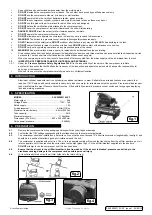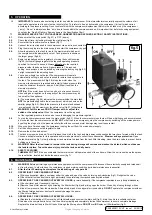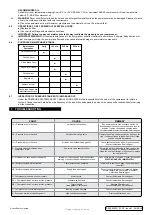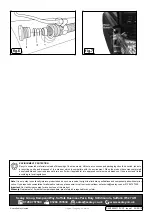
9
Keep children and unauthorised persons away from the working area.
8
do Not
dismantle the compressor for any reason. The unit must be checked by qualified personnel only.
8
do Not
use the compressor outdoors, or in damp, or wet locations.
8
do Not
operate within the vicinity of flammable liquids, gases or solids.
8
do Not
touch compressor cylinder, cylinder head or pipe from head to tank as these may be hot.
8
do Not
use this product to perform a task for which it has not been designed.
8
do Not
deface the certification plate attached to the compressor tank.
8
do Not
cover the compressor or restrict air flow around the unit whilst operating.
▲
dANGer! do Not
direct the output jet of air towards people or animals.
8
do Not
operate the compressor without an air filter.
8
do Not
allow anyone to operate the compressor unless they have received full instructions.
WArNiNG!
The air tank is a pressure vessel and the following safety measures apply:
8
do Not
tamper with the safety valve,
do Not
modify or alter the tank in any way and
do Not
strap anything to the tank.
8
do Not
subject the tank to impact, vibration or to heat and
do Not
allow contact with abrasives or corrosives.
8
do Not
carry out any welding operations on any pressurised parts of the vessel.
WArNiNG!
If an electrical fuse blows, ensure it is replaced with an identical fuse type and rating.
9
drain condensation from tank daily and inspect inside walls for corrosion every three months and have a detailed tank inspection carried
out annually. The tank shell must not fall below the certified thickness at any point.
9
When the compressor is not in use it should be switched off, disconnected from the mains supply and the air drained from
the tank.
1.3.
iNspectioN oF pressUre tANK Both iNterNAl ANd eXterNAl
1.3.1.
Under the
pressure systems safety regulations 2000
it is the responsibility of the owner of the compressor to initiate
a system of inspection that both defines the frequency of the inspection and appoints a person who has specific responsibility for
carrying out the inspection.
9
When not in use, store the compressor carefully in a safe, dry, childproof location.
2. iNtrodUctioN
Aluminium cylinder head with cast iron cylinder gives added resistance to wear. Suitable for on-site applications or anywhere that
requires 110V. Pump head directly coupled to heavy-duty induction motor for reliable and smooth operation. Precision welded receiver
tank manufactured to meet Pressure Vessel directive. Fitted with fully automatic pressure cut-out switch and twin gauges displaying
tank and working pressures.
3. speciFicAtioN
model:
....................................................
sAc2420e110v.v3
motor output: .......................................................................2hp
Voltage/Phase: ........................................................ 110V - 1ph
Rated supply: ..................................................................... 16A
Air displacement: ............................................... 6.3cfm(178/m)
maximum free air delivery: ................................4.6cfm(130l/m)
Tank capacity: .....................................................................24ltr
maximum pressure: ................................................ 116psi/8bar
dimensions (W x d x H): ...........................600 x 290 x 585mm
noise power/pressure ................................................. 96dB(A)
4. prepArAtioN
4.1.
Remove the compressor from its packaging and inspect for any shortages or damage.
4.2.
Confirm that the 110V voltage corresponds with the voltage shown on the compressor data plate.
4.3.
The compressor should be installed on a flat surface, or one that does not exceed 10
°
either transversely or longitudinally, (see fig.2) and
should be in a position that allows good air circulation around the unit.
4.4.
The compressor is supplied without oil in it. The oil is in a separate container. Remove the transit plug from the oil filler aperture, pour oil
into the aperture until it has reached the correct level on the sight glass (fig.3). Fit the oil filler/breather supplied into the aperture.
do Not
attempt to run the compressor until this has been done.
4.5.
ensure that the air vent in the oil filler/breather is free from debris. if the air vent is blocked, pressure can build up in the
crankcase causing damage to the compressor and possible personal injury.
4.6.
If it is not already fitted, screw the air filter holder into the inlet port (fig.4).
Original Language Version
© Jack Sealey limited
fig.1
fig.2
fig.3
fig.4
SAC2420e110V.V3 Issue 1 24/05/19























